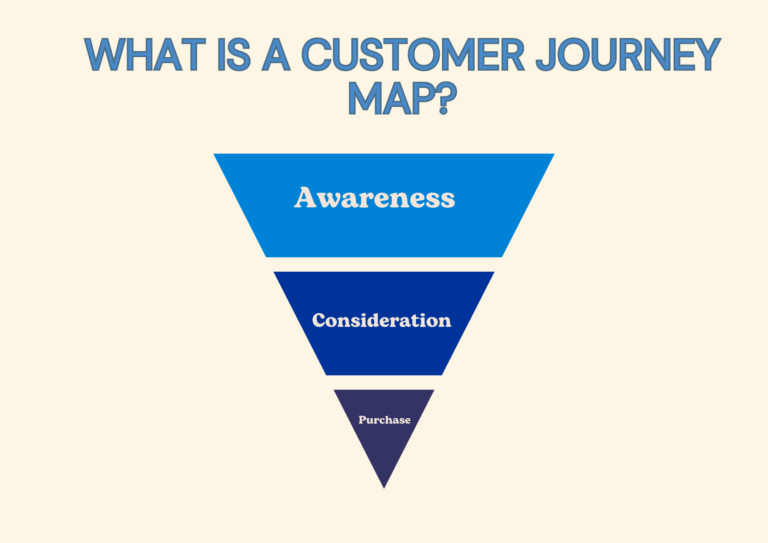What is a Customer Journey Map and How to Create One?
A customer journey refers to the complete sum of experiences that customers go through when interacting with a company and its products or services. It covers all the touchpoints and interactions a customer has with a brand, from initial awareness and consideration stages through the purchase process, post-purchase support, and eventually loyalty and advocacy.
This is what a customer journey typically looks like:
- Awareness: This is when a customer first becomes aware of a product, service, or brand. It could happen through various channels such as advertising, social media, word of mouth, etc.
- Consideration: In this stage, the customer evaluates the different options available to them. They might research the product or service, compare it with competitors, read reviews, and seek recommendations.
- Decision: This is when the customer decides to make a purchase. They might choose a specific product or service based on their research and preferences.
- Purchase: The customer completes the transaction and buys the chosen product or service. This stage could involve various processes depending on the nature of the product or service, such as online checkout, in-store purchase, subscription sign-up, etc.
- Post-purchase experience: After making the purchase, the customer interacts with the product or service. This stage includes using the product, seeking support or assistance if needed, and forming opinions based on the experience.
Understanding and optimizing the customer journey is crucial for businesses to provide a seamless and satisfying experience to customers. This ultimately leads to customer satisfaction, retention, and growth.

3 Main Stages of a Customer Journey Map
The customer journey, often visualized as a funnel due to its narrowing stages from awareness to conversion, represents the different phases of a potential customer. This funnel helps businesses understand and cater to the needs and behaviors of consumers at each stage. The core stages of the customer journey funnel typically include:
- Awareness: This is the top of the funnel (TOFU), where potential customers first become aware of your brand or product. This could be through social media, word of mouth, advertising, or search engine results. At this point, attracting the target audience’s attention and educating them about the solutions your product or service provides are the main objectives.
- Consideration: At this stage, prospective clients are figuring out whether your good or service can meet their needs or solve their problems. They assess features, costs, and benefits, contrast your products with those of your rivals, and contact your customer support or sales force for more in-depth questions. Strategies that work well include value proposition demonstrations, free trials, tailored communications, and targeted marketing.
- Purchase: The customer shows that they are ready to go ahead and buy the product. The customer makes a choice and completes the transaction at this point. Even though this is the funnel’s objective, the journey does not end here. Making sure that the buying process is easy and enjoyable is essential for the following phase.
This customer journey can vary greatly based on the industry, the complexity of the product or service, and the individual customer journey map.
Let us look at an example of the customer journey of a person buying a smartphone:
Step 1: While on social media, Sarah comes across an advertisement for the newest smartphone models. She becomes interested in the advertisement because it showcases the new model’s features.
Step2: Sarah starts looking up the new smartphone model online because she is intrigued. To find out more about the features, design, and user experience of the product, she goes to the manufacturer’s website, reads tech blogger reviews, and watches YouTube videos.
Step 3: Sarah evaluates features like camera quality, battery life, price, and accessory availability while contrasting the new smartphone with other models on the market. She also looks into other ways to get it, such as buying straight from the manufacturer’s website, via a cellular provider, or from an electronics store.
Step 4: After giving it some thought, Sarah chooses to buy the smartphone straight from the manufacturer’s website. She chooses her favorite color and storage size, adds the phone to her online cart, and checks out.
Step 5: Sarah enters her payment and shipping details to finish the transaction. She gets her new mobile phone. She shares her positive experience on social media, posting photos and videos taken with the phone and recommending them to her friends and followers.
Using awareness to advocacy as an example, this example shows how companies can help clients move through the funnel in order to increase sales and foster customer loyalty.
Having a customer journey pathway is a crucial step in defining the pathway a customer chooses to walk on. The journey becomes more than just transactions when each stage—awareness, consideration, decision-making, purchase, and post-purchase—is understood and optimized. To achieve growth and cultivate a loyal customer base, businesses must successfully navigate this journey.
